I got qualified for the Pro Tour in Minneapolis playing standard Mono Red Aggro. A lot of players were also asking if the tournament report and sideboard guide for Mono Red will be posted at Mystical Teachings. Even though I don’t usually create Standard content, I decided to write it as my way of saying thank you for all your support.
This is a part one of the article when I show my preparation process as well as a mini primer and sideboard guide. In part two, you’ll find a tournament report and my thoughts about Mono Red moving forward.
If you are new here, don’t forget to check out our Discord Channel. it’s free for everyone!
The preparation for the event
The return of Standard to the competitive scene was something I didn’t expect to see after the pandemic – Modern and Pioneer are extremely popular already, and the format was quite shitty in the past few years – it was hard to find an actually balanced Standard environment. My plan for the event was simple – find the best proactive deck available and tune it for the expected metagame. I tend to gravitate towards fast, proactive decks in general (mostly combo, but if that’s not a possibility then I’ll very end up playing an aggro deck), and I’m doing it partially because I’m not the fastest player on the planet. I like to spend some time on key decisions, and then have time between rounds to rest, eat snacks, etc. So all I had to do was to find it and learn how to play it. It sounds straightforward, but the whole process is a mix of a few variables and it’s actually quite hard to get it right. Did I nail it? I would rate my preparation 8/10 – it was solid, but I could make it better in some spots.
The first thing to do was check the calendar and prepare a plan – what steps need to be done and when. I started my testing on the 20th of February and the Regional Championship was held on the 11-12th of March. Three weeks of preparation is in my opinion enough to learn the format. There’s also one important point in the schedule: a bunch of other regions had their RCs a week before ours. The data from these tournaments was essential to see players’ trends and win rates of the most popular archetypes. The plan was quite simple:
- Week one: prepare a testing team, learn the format and try different decks.
- Week two: start settling up on an archetype and test different maindeck and sideboard configurations.
- Week three: adapt to the expected metagame based on results from already played RCs or, if my first deck of choice would turn out to be bad, switch to something else.
Week one
Creating a testing team was trivial this time – many good Polish players were qualified, including a few from my LGS, so it went quite naturally. In my opinion, it’s vital to prepare for those larger, more important events as a part of a group – there’s simply too much information to process for one person. Sharing insights is also important because you can see a topic from other perspectives. Jędrek, who was also qualified, created a great spreadsheet in Excel, so we could write down our results and share our opinions on different decks.

It’s relatively easy to learn about what’s at the top of the format and identify key cards for certain strategies. The first step is spending time examining top-performing lists from MTGGoldfish and learning what cards do. I took all the results from Standard Challenges and leagues with a grain of salt though – it was obvious to me that the more players start testing for their RCs, the better lists and archetypes will be. But my goal at that point wasn’t settling on my 75, but rather learning the ropes. It was very apparent from the start that the most popular, if not the best deck, in the format was Grixis. I realized that everything I’ll try should have a decent matchup against this deck or at least have a solid gameplan and a few cards out of the sideboard to address that matchup. Other popular decks at that time included: Mono White Midrange, Mono Red, Soldiers, and various Atraxa builds. Once I gathered the basic knowledge, I started playing games of Magic. I tested exclusively on MTGO – the average level of players is higher, the economy of the platform is more friendly compared to Arena and thanks to my Modern and Pioneer results I had a lot of play points and tix to spare. When I’m learning a new format, I often grab the fastest deck, which, for this and many other Standard formats, is Mono Red, so I can play as many games as I can and as a result, see many decks on the opposite side of the table. I had decent results, especially vs the most popular deck of the format – Grixis. Later, I tried Gruul (it was largely a worse version of Red) and UW Soldiers – they felt ok, but the lack of reach in form of burn and hasty creatures forced me to play a longer, more value-oriented play and led me to lose to dedicated hate cards like Brotherhood’s End more often. I also tried Mono Blue tempo for a bit, because it felt very powerful if it curved out well (bounce/countermagic in the early turns into turn 4-5 Haughty Djinn/Tolarian Terror with a backup). I quickly realized it’s not always the case though – the deck was good, but it was quite hard when it came down to sequencing and required very tight play. I kept going back to Mono Red because I had the best win rate with it – in week one it was over 65%. The deck felt insane, but I also expected the win rate would fall once players recognize aggro decks as threats.
After just a few days of testing, I came down to several conclusions. Shivan Devastator felt clunky – it was bad in the early turns of the game, when you want to create a tempo advantage. It should be considered as another four drop, not a cheap creature. It was obviously a good topdeck, but my main goal was to make the deck faster and more consistent. I wanted to cut it for something more useful in turns two and three. Since I felt I’m a bit short on removal that can kill x/3s (and there are a few important ones: Corpse Apprizer, Dennick, Pious Apprentice, Skystrike Officer, etc.) and decks in this Standard format tend to have targets for creature removal, I switched it for a third Strangle and never looked back. I also found out that Squee, Dubious Monarch sucks. I had no idea why players had it in the deck – it dies in combat to everything and 1/1 left after combat usually didn’t have an impact too. The second ability looks solid on paper against attrition decks, but again, 2/2 body is quite embarrassing and there’s a fair amount of exiling effects in Standard, including the Grixis all-star in Corpse Appraiser. I knew I didn’t want to play it, but the question was what could be better than that? My first try was Reckless Stormseeker, as 3/3 haste with upside felt like a good rate to me. It was fine, but every game it was sideboarded out for better options. I also tried maindeck Chandra, Dressed to Kill, but it was a very hit or miss card – in matchups focused around racing I wanted to have more creatures or removal, not a planeswalker, and Red is bad at protecting walkers if the opponent has a board as well. Other two drops weren’t good enough as well. That’s when I started scouring Gatherer to find some inspiration, and that’s how I found the real reason to play Red: Furnace Punisher.
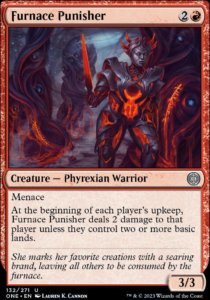
It turned out to be a great way to punish decks with three or more colours, which are very popular in the current Standard format. The body was also quite impressive – being a 3/3 means it can’t be killed by Cut Down and Bloodtithe Harvester with only one Blood token, and if you manage to put a +1/+1 counter on it, it dodges all three damage removal spells – Abrade, Brotherhood’s End, Parasitic Grasp, etc. Menace was the kicker that made the card insane – it was the reason why the card could be maindeckable. Even versus mono-coloured decks, it could sneak final points of damage, for example against Mono Blue and Mono White. It’s only truly bad in the mirror (three mana 3/3 that dies to cheap removal), but I could live with that since, as I mentioned before, the majority of the field was playing some sort of three-colour midrange. If played right (second main phase, after the opponent used a removal on your attacking creature), it’s a guaranteed two damage with the option for five more (three from combat + two from the trigger) in the next turn. What’s more important, opponents usually don’t have a luxury of keeping removal for a potential Furnace Punisher and have to react to what’s on the board, so they tend to play removal spells as soon as possible. That means that if Furnace Punisher is played as the last threat, it should quite often survive and take over the game. I had games when Furnace Punisher soloed the opponent – it was able to deal close to twenty damage. For me, this card was the main reason to play Mono Red.
Another interesting option was Falkenrath Pit Fighter. 2/1 on turn one was exactly what I wanted to play versus midrange decks, so their two mana removal couldn’t match the tempo it created. This line of play shines against Grixis where the opponent often has to play a two mana removal or block with a X/2 creature (Harvester or Goblin Shaman token) to kill it. I tried a list with four Pit Fighters, but the lack of haste when I was drawing multiples felt clunky. Eventually, I decided to play a 2/2 Pit Fighter//Phoenix Chick split to minimise their drawbacks – Pit Fighter’s lack of haste and evasion and Phoenix Chick’s lack of two power. Drawing more than two copies of either of them felt bad in almost every case, so splitting the difference made sense and paid off for me.
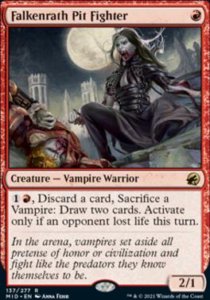
Week two
At the beginning of week two, I was playing a bit with UW Soldiers, because I thought I could gain a few percentage points if I could get more proficient at playing it. For better or worse, the hours dedicated to mastering the deck didn’t give me the results I wanted – I was winning visibly less than with Mono Red, so I went back to my very first choice. At this point, I was very close to being locked on the deck. It was the last call for any major changes – getting cards turned out to be not as trivial as many of you would think. I didn’t have any problems with staples – for example, I had access to twelve Fables and any manabase I would like to play. Getting commons and uncommons turned out to be a real challenge. I still bought or borrowed cards that could be useful for any aggro deck in the format.
I was still working on the decklist. My maindeck felt smooth, but the sideboard was misbuilt – I was siding in the same cards over and over again, and the rest of them were not being used at all. I tried many different strange cards that finally got cut:
- Brotherhood’s End. It was one of the biggest mysteries of other red lists for me – why was this card even considered? I guess that the idea behind it was that versus other creature decks, for example Soldiers, catching them off-guard after they overextend a bit was a way to steal otherwise lost games. However, with a high density of point removal, it was very hard for them to build an advantage on board in the first place. The best plan against them was to play Monastery Swiftspear + another creature and kill everything they play while working on their life total in the process. Brotherhood’s End doesn’t fit this plan at all.
- Bloody Betrayal. I was playing this card for a while, but never got a chance to steal the number one target – Atraxa, Grand Unifier. My Reanimator opponents either were losing before it happened or were winning with other cards. At the end of the day, I was more comfortable with siding in cards that aren’t that narrow – Rebel Salvo for Sheoldred, or Unlicensed Hearse to not let them reanimate anything felt better and both cards were more useful in other matchups.
- Jaya, Fiery Negotiator. Against midrange decks, switching into more value-oriented aggro was a very effective strategy – Chandra, Dressed to Kill was great and I wanted to have more effects, but with a different name, so I could have both on the battlefield. Jaya was very promising at first, but after a few games, I came to the conclusion that it was not impactful enough. Her plus ability isn’t something that will help you when you are behind – 1/1 Prowess creature for four mana is a stinker. Draw engine could be effectively used if you untap with her, which didn’t make it a reliable source of card advantage, and the removal ability worked only if you were already ahead.
- The Elder Dragon War. An interesting modal card that sadly didn’t fit that well into the strategy. The most common chapter I was selecting was definitely the final one – a 4/4 flyer for four mana was pretty alright, but still not good enough to justify running the card by itself. Other abilities turned out to not be as impactful as I hoped. Mass looting in the late game often changed one, maybe two cards and two damage to each creature didn’t match up well with what we were trying to achieve – flood the board in the early game.
- Giant Cindermaw. The idea behind this card is to stop lifegain from Sheoldred, Atraxa and other smaller threats like Dennick. The problem is that Cindermaw doesn’t match up well with any of these cards – Furnace Punisher is just better against Sheoldred, since it also ‘negates’ their lifegain, but can attack into a 4/5. Stopping lifegain won’t win versus Atraxa – they’ll just find a removal spell and win anyways. And against other smaller lifelinkers, it’s better to play a removal spell – it’s cheaper and will let our creatures attack.
- End the Festivities. In theory, it should be good against Toxic and decks with Wedding Announcement. In practice, I never wanted to draw it and a regular burn spell often looked just better.
- Torch Breath. The matchup vs Mono Blue felt quite tough – fast Djinn was a huge problem for me. Torch Breath was my idea to stop the turn four x/4 with a counter backup. I had one or two moments of glory with this card, but it turned out to be too narrow to be played.
Week three
Monday, 6th of March, was a very important day for our testing. We got the data from Regional Championships that took place at the weekend. If you haven’t seen the data, check out the graphic prepared by Frank Karsten.
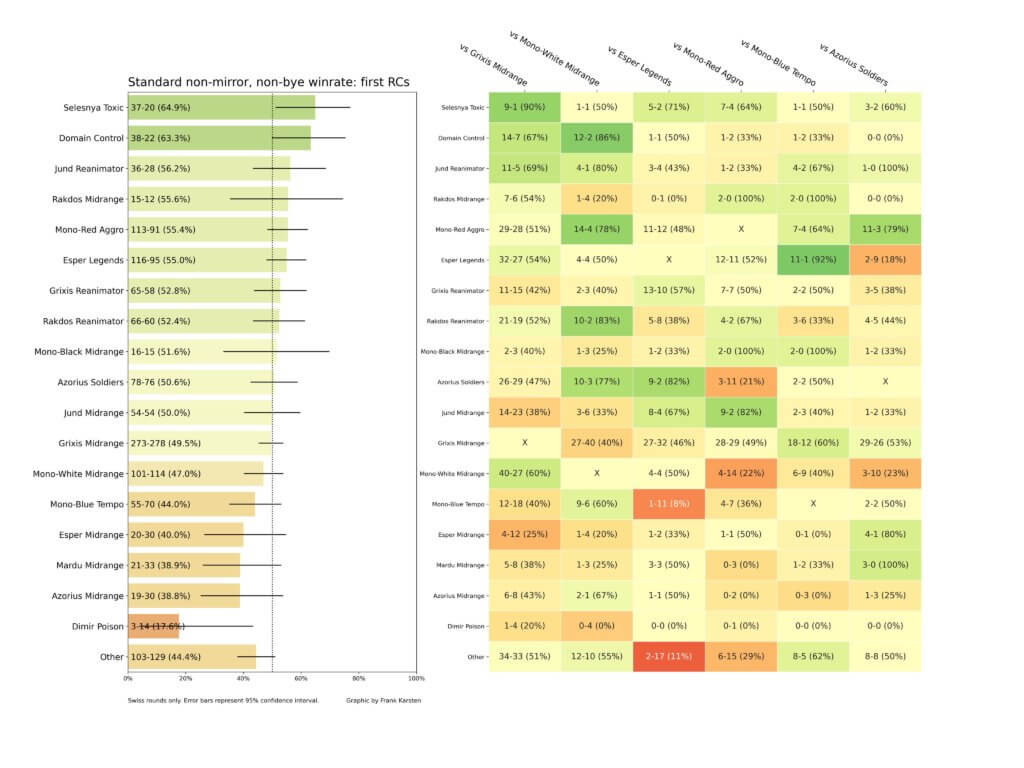
From a Mono Red player perspective, these results were less than ideal. Red got a solid, 55,4% win rate. Some would say that it was a good thing – getting a prove that Red is good – but from my perspective, the information was useless for me – I already knew it after two weeks of testing. What’s more important, it was a clear sign for non-Red players to prepare for aggro matchups. If we combine it with how well GW Toxic did, it was more than certain that players will tune their sideboards or even maindecks to beat aggro. For example, in the early stages of my testing, it was very rare to see a one mana removal spell in Grixis’ maindeck. After the first batch of RCs, I expected to see one, maybe two copies main and more postboard. Another bad sign was how well Esper Legends went. It’s a challenging matchup for Red and the deck sitting at 55% win rate was a dangerous situation – it meant that some of the midrange players could switch from much more popular, but less successful Grixis to Esper. There were also other, less important conclusions. For example, Domain Control and Jund Reanimator surprised everyone with good performances. I also expected more from Soldiers and Mono Blue.
Because of these reasons, I was considering a switch to something else. Toxic was a natural choice for me since it was an aggro deck I missed earlier and it had an insane win rate. But my results with it were less than ideal – it felt very high variance in terms of what kind of draws you’ll get. You could get tempo starts with a lot of one drops, or draws that were good against commonly played removal spells with Bloated Contaminator (dodges Cut Down and burn spells) or Skrelv’s Hive. The lack of good removal and weak sideboard options were enough for me to not jump onto the Toxic hype train. Although I have to say that I liked the version popularised by kanister, with Audacity and Valorous Stance in the maindeck. A small part of me wanted to test Mono Blue again, but the numbers convinced me to not do so.
After all the different shakeups and pivots in testing, I once again ended up playing Mono Red. I haven’t found anything better and I was betting that not that many players will make major shifts and they will play what they already own and only tune the list for expected metagame. I liked my maindeck a lot, but I wanted to upgrade my sideboard, so I started looking for any innovations in lists from the Pacific Regional Championships. I found this list from Japan.
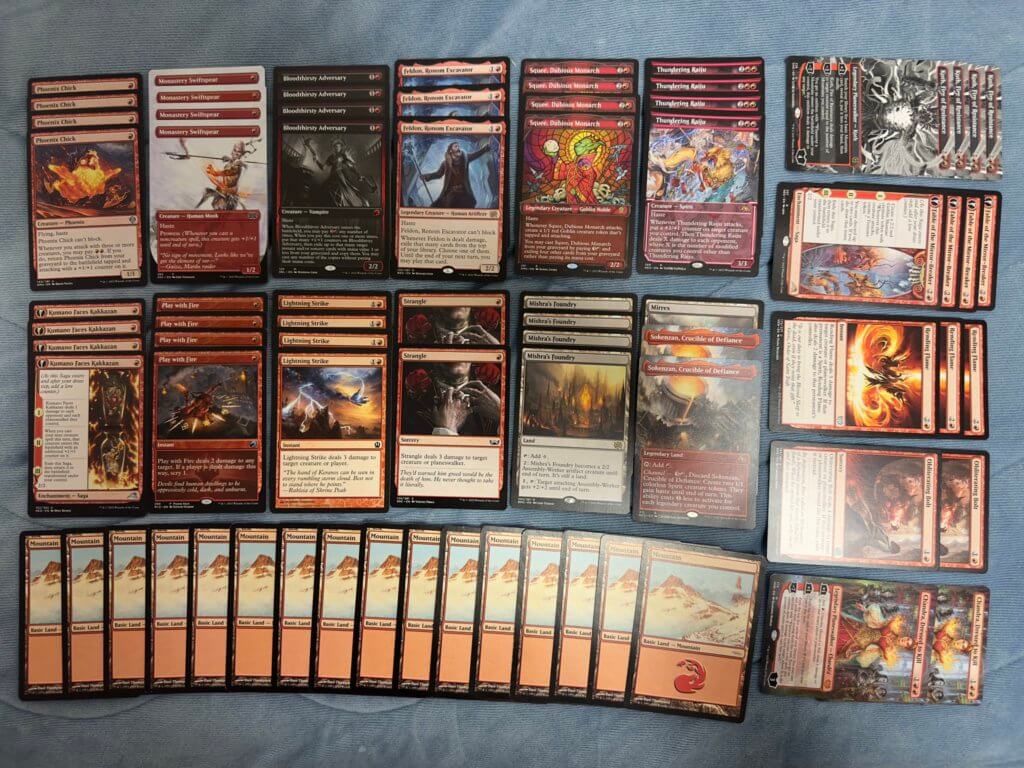
I obviously didn’t like Squee, but the rest felt promising. The plan to go full value postboard against Grixis with a full playset of both Koth, Fire of Resistance and Fable of the Mirror-Breaker, as well as some Chandras sounded good in theory. However, after playing a few leagues with the list, I had mixed opinions about it. Against Grixis, a fast Koth and going for ultimate was fine as long as the opponent wasn’t aware of this plan because they already had a great answer for that – Invoke Despair. If they answer Koth before we ultimate, we’ll end up spending four mana to get one or two Mountains, which is less than ideal. There’s also a second ability that was surprisingly effective removal, especially in mid game – it was a good way to kill high-toughness creatures like Sheoldred or Serra Paragon. Fable of the Mirror-Breaker turned out to be weaker than I expected. Don’t get me wrong, it’s a great card, but I just didn’t feel the deck needs this effect, at least for the expected metagame. Postboard, my opponents were ready to deal with x/2 creatures, and I couldn’t get value from the rummaging part of it – in theory discarding Phoenix Chicks could be good, but I often wanted to play it earlier to start pressuring the opponent, rather than waiting in order to get some marginal value (which rarely happens anyways, since Corpse Appraiser often exiles the Chick anyways). Some would say that Fable card filtering works well with Koth tutoring for Mountains, but in my opinion, it’s a classic ‘win more’ situation – if you can keep spinning the wheels with both of these cards to make it work, you should most likely be able to finish the game anyway. The last thing I like in the decklist was playing more manlands – I wasn’t considering playing a full playset of Mishra’s Foundry, but they turned out to be good in mid and late game as extra threats to deal final points of damage, and they rarely had a negative impact on my plays in the early game. Mirrex felt far too slow to matter.
After nearly three weeks of testing, I registered this list:
Short reasoning why it’s built like that and a sideboard guide
If you are here only to get my insight on Mono Red and sideboard plans, below you’ll find everything you need. If you’ve already read about my tournament preparation, you can see that some information was repeated below, for the sake of convenience.
The general concept and core of the deck
Your main goal is to pressure the opponent in the early game. If just attacking is not enough to finish the game, use burn spells, Furnace Punisher and Thundering Raiju to finish the game.
One drops: Kumano Faces Kakkazan, Monastery Swiftspear, Phoenix Chick and Falkenrath Pit Fighter

The easiest way to win the game with Red is to be on the play and start with a one drop into a two drop. Kumano Faces Kakkazan is the best card for this plan – it makes your turn two play more powerful – for example, your 2/2 becomes 3/3 and it can attack into Thalia, Guardian of Thraben or dodge Cut Down. Monastery Swiftspear is also great, especially if your plan in the matchup is to play creatures early and control the board with burn spells. Phoenix Chick and Falkenrath Pit Fighter are worse than your two primary one drops, but you need to set up the pressure, so a certain density of one mana threats is required. I decided to split the worst one drops to minimise their drawbacks. Drawing too many Chicks felt underpowered. One power creatures, even with evasion, just couldn’t kill the opponent quick enough. 2/1 on turn one will deal more damage if left unchecked – Pit Fighter was added mainly to improve the matchup against Grixis and it’s a solid turn one play versus them. It also has a somewhat relevant ability in the mid game, once it gets bricked by larger creatures on the other side of the board. On the other hand, giving a +1/+1 counter on a creature without haste doesn’t feel that great.
Two drops: Bloodthirsty Adversary and Feldon, Ronom Excavator

In most situations, they will act as basically the same card – two mana hasty 2/2. Again, a critical mass of threats is needed to get ahead on tempo. Adversary is also a decent card in mid and late game because of its ability – that part of the card shines the brightest postboard, especially when Rending Flame is sided in – replaying it and killing a high-toughness creature can create a massive advantage. On the other hand, Feldon is more aggressive – because of its ability, you can attack into bigger creatures and it often won’t be blocked because opponents don’t want to give you extra resources to work with. That’s why if I have a choice, I tend to cast Feldon first. Also note that it’s legendary, so trading the first one so you can cast the second one post combat is often a good line of play.
Top-end: Furnace Punisher and Thundering Raiju
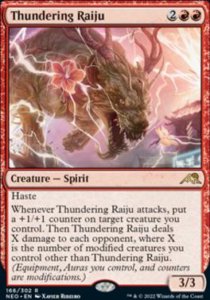
In my opinion, Furnace Punisher is the reason to play this deck. A great way to punish greedy manabases that nearly everyone runs in the current Standard. Good versus Grixis, Esper, GW Toxic, UW Soldiers, and other multicolour decks. Try to play it after the opponent uses all of their removal for your other creatures. Even better if you can make it a 4/4 with the help of a counter from Kumano to play around Abrade. Also, don’t forget about Menace – it will help you deal even more damage in mid game.
Thundering Raiju is a way to push damage through blockers. Making one of your attackers bigger will often change a situation from a chump attack into trade with one of the opponent’s creatures. You can also put a counter on Raiju and make it 4/4, so it won’t die so easily in combat or to protect it from damage based removal once the opponent untaps. Note that Raiju’s trigger checks for all other modified creatures – it won’t count itself, but everything else is fair game.
Some of you would ask why I don’t run Squee, Dubious Monarch. The truth is that the card is just bad – it’s not very efficient and there are plenty of exile effects in the format. Furnace Punisher is just a much better card to run in those slots.
Removal: Lightning Strike, Play with Fire and Strangle

Red burn spells are usually used to clear the way for our creatures. Sometimes, you can go face, but my advice is to do it only if you know you’ll win using a burn plan or you have a good window to deal a few extra points of damage with unchecked Monastery Swiftspears. Don’t forget to scry with Play with Fire if you target your opponent with it!
Some of you would ask why I play three Strangles. In this Standard format every deck has creatures to kill. Strangle won’t be able to trade one for one only against Mono Blue – every other deck has targets of varying degree of importance. It very often trades up for mana, and killing their blocker usually means the difference between keeping the pressure on or having to pass without dealing damage – that’s a huge deal for an aggro deck. That’s why I value Strangle so highly. I don’t even mind two for one-ing myself in order to kill bigger threats. For example, killing Sheoldred after it blocked out 2/2 happens quite often. As long as you have the tempo advantage, going down a card won’t be a problem. In my opinion, Strangle is a very important piece of Mono Red and I was very happy with my three + one split.
The manabase
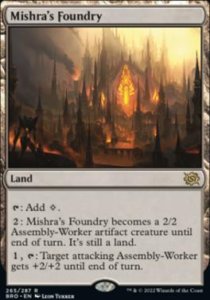
In this deck, it’s very simple – I play Mountains because they don’t have any restrictions and can cast all of my spells. My mana is so good that I can afford to play four Mishra’s Foundry – they’re great at creating a critical mass of attackers versus opponent’s removal and they work great with each other – attacking with a 4/4 land is quite hard to stop. I also play two Sokenzans, just as a way to have an extra way to mitigate flooding. The question is how many lands should be in this deck. I decided to go for 22 lands, but I can see going up to 23, so I could cast Thundering Raiju on turn four more often. I didn’t know what to cut, so I kept it this way. But going up a land would probably be the right call.
Sideboard options
Planeswalkers: 3 Chandra, Dressed to Kill and 3 Koth, Fire of Resistance
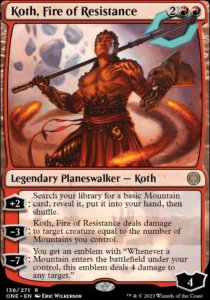
Against removal heavy decks, having another line of attack is very effective. At first I had only Chandra – it’s great in Red. Extra mana in the mid game is useful for double spelling or casting Bloodthirsty Adversary with ‘kicker’. Pings can finish the opponent in the boardstall situations or kill planeswalkers. Card advantage engine is quite random (you won’t always reveal a red card since lands are colorless), but it lets you not run out of fuel. I’ve never used Chandra’s ultimate, but it forced many opponents to cast bad Brotherhood’s Ends to not let it happen. There was also a moment when I was playing only Koth as an alternate win condition and removal for high-toughness creatures, but eventually, I came to the conclusion that they work great together – Chandra gives you an extra mana on turn four, so you’ll always be able to cast it. It also protects Koth from Invoke Despair. They create a great card advantage duo – Chandra finds more threats and Koth acts as a removal for opposing creatures. If this duo is left unchecked, it just wins games.
3 Obliterating Bolt
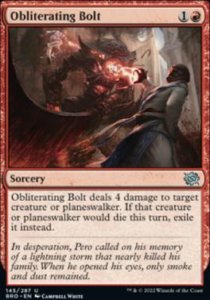
There are some x/4 creatures I wanted to have a clean answer for: Serra Paragon in White Midrange, Adeline, Resplendent Cathar, Raffine, Scheming Seer, and Ao, the Dawn Sky in Esper Legends, Bloated Contaminator and Annex Sentry in Toxic, and Haughty Djinn in Mono Blue. Exiling a creature can also be relevant from time to time. I was considering playing four, but decided to have more answers for Sheoldred.
3 Rebel Salvo
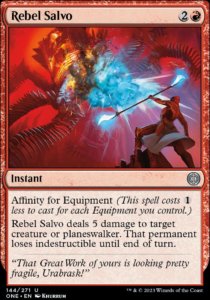
Some sort of removal for Sheoldred is needed. I wanted to play Rending Flames instead since there are more Spirits and indestructible creatures in the format, but I couldn’t get them in time. Luckily, it didn’t cost me at RC. I was considering playing only two (and four Obliterating Bolt), but decided against that because I expected a lot of Esper and they often play four Sheoldreds.
2 Unlicensed Hearse
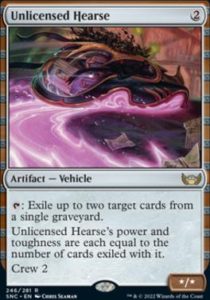
it’s clearly the worst card in the sideboard and if you want to try out something else, Hearse and Strangle are the first cards to go. Its purpose is to help me a bit with Reanimator decks and Mono Blue.
1 Strangle
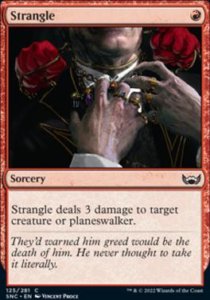
Just another efficient removal for small creatures. It’s not essential by any means, but I liked the card so much that I wanted the fourth copy in the board.
Tips and tricks
- Pit Fighter’s ability can be enabled by any damage dealt, not only in combat, and there’s a good amount of cards in the deck that can enable it without attacking successfully: Kumano Faces Kakkazan, Thundering Raiju, Chandra and Furnace Punisher. The last example is the most unique since it deals damage on the opponent’s turn. You can, for example, chump block and sacrifice Pit Fighter before damage, so the opponent won’t gain life from a blocked lifelinker.
- Try to sequence your early drops correctly to make the opponent’s removal as awkward as possible. For example, if the opponent represents Abrade or Brotherhood’s End, go for Felton instead of Adversary, so you’ll get a card back. Or if you are worried about board wipe, go for Kumano or a planeswalker instead of another creature.
- You can save Monastery Swiftspear from Cut Down by making it bigger with a burn spell in response. This line is extremely useful after T1 Kumano into T2 Swiftspear with Play with Fire in hand.
- You can pay three extra mana to make Adversary bigger even if you don’t have a spell in a graveyard. You also don’t have to target or exile anything if you for example can’t cast a flashback due to Thalia’s tax.
- If you go T1 Kumano into T2 3/3 Feldon, you can Play with Fire targeting it later on so you can trade it for draw one out of 2 exiled cards. This line is useful when you are looking for lands or some impactful play like Koth or Raiju.
- Strangle, Obliterating Bolt and Rending Flame can also deal damage to planeswalkers. It’s rare but can happen.
- Thundering Raiju’s trigger won’t count itself, but it will ‘see’ each creature with a counter, regardless whether they’re attacking or not.
- If you have double Raiju ready to attack, be careful about how you stack triggers. Do it in a way that each Spirit will see as many modified creatures as possible.
- Think about what lands you play if you have Koth in the deck. Sometimes one Mountain can be the difference between winning and losing.
- Learn how to protect Mishra’s Foundry. By itself, it can’t be killed by Go For the Throat (because it’s an artifact), and if the opponent will let you attack and you have another Mishra’s Foundry ready, you can keep it open and activate whenever the opponent tries to Abrade or Cut Down it.
Sideboard guide
For this sideboard guide, I will use Rending Flame instead of Rebel Salvo. They do the same, but Rending Flame’s upside will be more often used.
You can also download a sideboarding cheat sheet, so you can use it at your next event.
Standard Mono Red Aggro – sb cheat sheet
Grixis

In: 3 Chandra, Dressed to Kill, 3 Koth, Fire of Resistance, 2 Rending Flame, 1 Strangle
Out: 4 Thundering Raiju, 3 Play with Fire, 2 Phoenix Chick
It’s a good matchup for Red, or at least my version is well-equipped to deal with their most common lines. They need to curve cheap interaction into multiple Corpse Appraisers or Fables into Sheoldred to have a chance. If they really want to win the matchup, they can opt for maindeck Cut Downs and Brotherhood’s Ends instead of some top end cards that are good in the mirror, but it’s quite rare from my experience.
Flood the board with small creatures and win before they draw everything they need. Bonus points if you can start with a one drop – they will most likely use a two mana removal spell to deal with it, so you’ll end up with a tempo advantage. The best scenario for Red is when they play early creatures instead of interacting with your board, so you can punish them for that with your own burn spells, removing their blockers and keeping the tempo advantage. If possible, play around Make Disappear by keeping two mana open. Wait with Furnace Punisher and use other cards first, so they’ll waste their removal on other threats – once Punisher hits the board and stays there, it’s hard to lose. If they play Sheoldred, don’t be afraid to two for one yourself to kill it. On the other hand, the opponent may be scared of you having a burn spell in hand to finish it after your attacks, so they might not block with it. That’s why attacking with your team of 2/2s can still be effective against it.
Postboard, the situation changes a bit, as they will switch their expensive cards for more cheap removal. In my opinion, the best line of defence against it is to attack from a different direction – planeswalkers are ideal for that. They will force the opponent into taking a more aggressive route instead of full defence, so it will be easier to punish them with our removal spells. The problem was what to take out. I came to the conclusion that Thundering Raiju in the matchup is quite hit or miss, since you often pay four mana for it and it only costs your opponent two to answer it. I also side out Phoenix Chicks since they just don’t attack for that much damage and Play with Fire because it’s the worst card left – it can kill Harvester or creatures from Fable, but won’t be able to deal with Appraiser or finish Sheoldred after it blocked a 2/2.
Grixis Reanimator
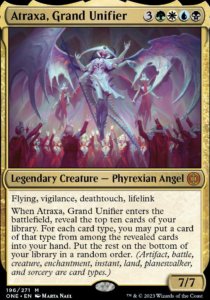
In: 3 Chandra, Dressed to Kill, 3 Koth, Fire of Resistance, 2 Rending Flame, 2 Unlicensed Hearse
Out: 4 Thundering Raiju, 4 Play with Fire, 2 Phoenix Chick
A similar matchup to regular Grixis – our goal is to leverage the tempo advantage and win before they take over with their payoff, and we have the tools to do just that. However, they have one twist that makes it much more problematic – instead of Invoke Despair, a few other expensive cards and two or three cheap removal/counters, they run Atraxa, Grand Unifier and The Cruelty of Gix. If you let them untap with Atraxa, the game is over. In game one there’s not that much we can do about it outside of racing it – and I can say that this strategy is quite effective. They don’t have that much card manipulation, so the odds are in your favour. Another thing that can help you is their manabase – Atraxa players tend to add a few white and green sources so they can hardcast Atraxa in midrange fights, but this approach can cost them tempo versus Red.
Postboard the strategy is very similar to what we were doing against Grixis – play early creatures and threaten an attack from a different angle thanks to planeswalkers. The only addition to the mix is Unlicensed Hearse – if you can exile Atraxa with it, it’s a huge win for you. You can also exile Appraiser’s targets so they won’t get a card from its ability.
Esper Legends
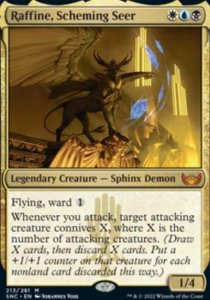
In: 3 Rending Flame, 3 Obliterating Bolt, 1 Strangle
Out: 3 Play with Fire, 2 Falkenrath Pit Fighter, 2 Phoenix Chick
It’s a very challenging matchup for Red. Their creature suite is well-equipped to fight us. Sometimes they’ll curve Skrelv, Defector Mite into either Dennick or Thalia and it’ll already be an uphill battle for us. If they follow it up with some high-toughness creatures like Raffine, Scheming Seer, Adeline, Resplendent Cathar or Sheoldred, it’s really hard to come back – we just don’t have tools to break through. The only way to deal with it in game one is to go under and deal early damage with our small creatures and make them bigger later with Raiju or deal final points of damage with Furnace Punisher. Punisher is great in a matchup because they don’t have that much creature removal so once it sticks, it should function as a one-sided Sulfuric Vortex. Unfortunately, your creature removal is quite bad in game one – it can’t kill some of their top-end threats, and it often costs more due to Thalia and Ward from Raffine. Kill Dennick as soon as possible because if you let them untap with it, the follow up Raffine will make it into a 3/4 lifelinker, which is almost impossible to outrace and requires two removal spells to be answered in game one. Also, watch out for Channel lands! If the opponent has a lot of legends on the battlefield, they can be as cheap as one mana. Plaza of Heroes can also be annoying, so think twice about the timing of your burn spells.
Postboard, the situation gets a bit better since we change our bad cards and add a few good removal spells. The best approach to the matchup is to play two creatures and kill everything they play. Sadly, the plan can fall in several moments – Skrelv, Thalia, tricky Raffine giving a few Connive triggers, etc., so it’s still an uphill battle. From the Esper side, you can expect some cheap interaction like Cut Down and possibly sweepers like Temporary Lockdown, but you will rarely be able to afford to play around them.
Mono White Midrange
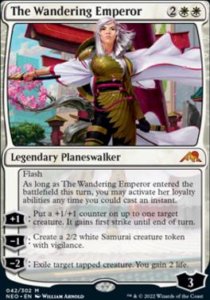
In: 3 Obliterating Bolt, 3 Chandra, Dressed to Kill, 2 Rending Flame, 2 Koth, Fire of Resistance
Out: 4 Play with Fire, 4 Furnace Punisher, 2 Falkenrath Pit Fighter
At the first glance, the matchup looks similar to Grixis – you have early pressure and tempo, they are trying to slow you down and take over the game with more expensive threats that create card advantage. There are two problems though. The first one is that our non aggro way of winning midrange matchups – Furnace Punisher – doesn’t work. Second is that Mono White has better tools to avoid falling back on tempo than Grixis: four Lay Down Arms as a one mana removal spell is huge. Steel Seraph, especially when it comes into play right after turn two Reckoner Bankbuster is a must-kill threat. Loran of the Third Path can destroy Kumano and trade in combat with any of our 2/2s. And they have a good top end as well – Serra Paragon, The Wandering Emperor and Ao can easily dominate the game if left unchecked. It’s a good mix of cheap answers and efficient threats. To beat it in game one, you need to go under and hope they won’t have one of their puzzles before you kill them. You’ll get much less time compared to Grixis to close out the game – eventually, they will find some constant source of lifegain and will lock you out of the game. Still, it’s possible to run them over, assuming you are on the play.
Postboard games are a bit better for us. They will add a few more removal spells and possibly more Steel Seraphs, but in turn we’ll get removal for their x/4s. Koth can either be yet another burn spell or an alternate win con that should overpower even their late game engine – their only way to interact with it is Ossification, and it will likely be used for cheaper threats earlier. What to take out is the tough question. Pit Fighter is an easy choice – it can be blocked by both of their two drops in Spirited Companion or Ambitious Farmhand. Play with Fire doesn’t have any great targets so it gets cut as well, and Furnace Punisher doesn’t shine either. As a result, my mana curve post side is much higher compared to my game one composition. I was thinking a lot about trimming Thundering Raijus, but I came to the conclusion I need extra power. In this situation, I would love to have a 23rd land and side out something like Lightning Strike, so I could play my fourth land on curve more often.
Mono Red

In: 3 Chandra, Dressed to Kill, 2 Rending Flame, 1 Strangle
Out: 4 Furnace Punisher, 2 Phoenix Chick
This mirror is quite unexciting. The one who wins a dice roll has a big advantage. There are two ways how the matchup plays out – it’s usually a hard race with a massive advantage for the one who was on the play. Sometimes it evolves into a resource battle that ends in a topdeck mode. In my opinion, the mirror is about getting on the board early and keeping the removal, so the opponent can never come back to the game. I know that dealing damage to opposing Feldon is not ideal, but unless you have a high chance of winning the race, I recommend killing it, even if the opponent will get a card back – usually tempo is more important than card advantage here. Starts with turn one Kumano or Monastery Swiftspear are much better than without them. Pit Fighter is fine since it trades with Kumano and two drops. The most swingy card in the mirror is by far Thundering Raiju. If possible, keep Lightning Strike open to kill it. On the other hand, if the opponent taps out, you can punish them by attacking with your own Raiju and putting a counter on it – when it becomes a 4/4 it’s hard to lose.
Postboard I tend to side in Chandra as a way to generate card advantage in the topdeck mode. It also makes double spelling in mid game more doable. I don’t like Koth that much, since in practice it will be a four mana removal spell and that’s it – the odds to protect it so it can ultimate are so low that I don’t even want to start doing it. I also like adding more removal, but it’s not as good as it looks – it’s either sorcery speed, so the opponent’s hasty threats will at least deal some damage in a process, or it’s three mana, so it’s hard to cast other spells while holding it.
UW Soldiers
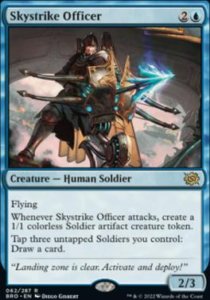
In: 3 Obliterating Bolt, 1 Strangle
Out: 2 Falkenrath Pit Fighter, 2 Phoenix Chick
I’ve heard all kinds of opinions about this matchup: some people saying it’s a bye for Red, others who say it’s quite hard and the same discrepancy from Soldiers perspective. In my opinion, the truth is somewhere in between – both decks have tools to combat each other. Soldiers have Dennick as a good standalone threat, going wide and pumping the team with Valiant Veteran and just good cards in the form of Skrelv and Thalia. Their three drops – Siege Veteran, Skystrike Officer, and Brutal Cathar – are very hit or miss. If they survive, they will quickly build an advantage that in the long run will dominate the game, but if we can kill them while applying pressure (Strangle shines here), we can get the tempo advantage and force them into trades that are profitable for us. This approach to the matchup – play cheap creatures and kill whatever they play – is the best way for us to win. Kumano Faces Kakkazan, or to be exact its flipped version, is surprisingly effective against Soldiers – they have four different creatures that use the graveyard in one way or another, and stopping it by just having a 2/2 on the battlefield is huge. Other plans like Furnace Punisher stompy or racing with Raiju can also be effective, but they cede the initiative to the opponent and give them a chance to run away with the game.
Postboard we pack a ton of removal and hope they won’t draw all their sideboard. Soldiers players are often well prepared against red. Extraction Specialist is their way to come back after our wall of removal. Lantern Flare can be annoying in race situations, but our main gameplan for this matchup – killing their creatures – will make it less impactful than it could be, so it’s not the biggest problem ever. They can also have more Brutal Cathars (although they aren’t at their best in the matchup), Knockout Blow, etc. Overall, just do your thing and do not let them have too many creatures on the battlefield – you have enough removal to keep their side of the table contained.
GW Toxic
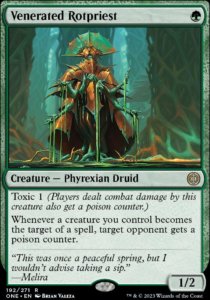
In: 3 Obliterating Bolt, 1 Strangle, 1 Rending Flame
Out: 2 Falkenrath Pit Fighter, 2 Phoenix Chick, 1 Lightning Strike
It’s a very lopsided matchup, both because of how important winning the die roll is and how the opponent’s openings are different from each other. Toxic can present either good rares or underpowered threats. For example, from Red’s perspective, Jawbone Duelist or Slaughter Singer are easy targets for our cheap removal. On the other hand, the opening with multiple one drops into Skrelv’s Hive or Bloated Contaminator is quite hard to beat. When you are on the play, you can try to never let them activate Corrupted – this will make Hive and The Seedcore much less impactful. Watch out for Duelist’s double strike and how it can set up Corrupted (and lifelink in a process) in first strike. On a draw, it’s very hard to do so, so all you can do is hope they won’t draw Hive. Speaking of a white Bitterblossom, Shrelv’s Hive is a strange card in a matchup. Usually, it’s really good, especially if drawn later on when we are in a race situation as giving lifelink to all of their creatures out of the blue is usually game-changing. On the other hand, if the opponent kept a hand that relies on Hive creating tokens and connecting with them, it’s relatively easy to keep them in check – just attack with all but one X/2 creature and block their 1/1s. By doing this, you’ll never let them activate Corrupted and their life loss from Hive will help you. Another important card in a matchup is Tyvar’s Stand – observe how your opponent uses their lands to infer whether they have it or not. In this matchup, it’s possible to go full control and win with Furnace Punisher triggers – just set up enough blockers, kill their key creatures, and wait until they die.
Postboard, they will get access to a few bad removal spells (for example Lantern Flare) and Knockout Blow. You’ll get a good removal for their x/4s, so it’s a good trade for us.
Mono Blue
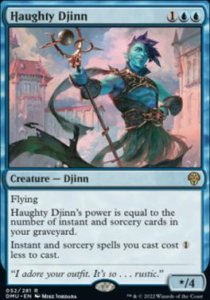
In: 3 Chandra, Dressed to Kill, 3 Obliterating Bolt, 3 Rending Flame, 2 Unlicensed Hearse
Out: 4 Furnace Punisher, 4 Play with Fire, 3 Strangle
This matchup comes down to two things – whether they have a good draw or not, and whether you can start the game with a good one drop. Falkanrath Pit Fighter shines here – if played on turn one on the play, it can deal up to eight to ten damage with relative ease. Still, if they curve out Fading Hope into Make Disappear into Haughty Djinn, it’ll be extremely hard to win. Playing around their counters rarely does anything – if you stop casting spells, you’ll get them time to cast cantrips so they can find their finishers. Slam everything and hope for the best.
Postboard, side in the removal that is capable of killing Djinn, as well as Unlicensed Hearse – if you manage to play it on turn two before they play a second land drop, it’s very likely you’ll keep their Djinns powerless and never let them cast Tolarian Terrors. I also like siding out Play with Fire and Strangles – sure, it’s possible to attack into Djinn with a bunch of 2/2s and finish it with a one mana burn spell, but in practice, our board is rarely wide enough so we can’t afford two for ones. It’s usually better to try to kill it with Obliterating Bolt or Rending Flame, and use other cards to set up a critical mass of creatures.
